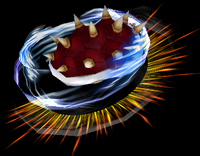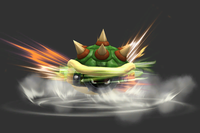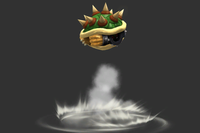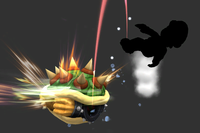Whirling Fortress: Difference between revisions
(minor touch-ups) |
SuperSqank (talk | contribs) |
||
| Line 12: | Line 12: | ||
==Overview== | ==Overview== | ||
When using Whirling Fortress, Bowser retreats into his shell and spins rapidly while damaging nearby foes. It is similar in execution to [[Donkey Kong]]'s [[Spinning Kong]], being a move that makes the user quickly spin around with a mostly-horizontal recovery, though in later games the two have been somewhat differentiated. | When using Whirling Fortress, Bowser retreats into his shell and spins rapidly while damaging nearby foes. The grounded version initially only had two hits but as of ''Super Smash Bros. 4'', it is a multi hitting attack, with the aerial version has always been a multi hitting attack. It is similar in execution to [[Donkey Kong]]'s [[Spinning Kong]], being a move that makes the user quickly spin around with a mostly-horizontal recovery, though in later games the two have been somewhat differentiated. The move has very low startup lag in every game (especially compared to the rest of Bowser's moveset), which makes it a notoriously strong [[out of shield]] option in every ''Smash'' title, being a key part of how Bowser gets out of disadvantageous game states. | ||
This special attack is shared by [[Giga Bowser]], both in his boss appearance in ''Melee'' and in his [[Giga Bowser (Final Smash)|playable appearance]] in ''Brawl'' and ''Super Smash Bros. 4''. It grants him multiple frames of [[invincibility]], making it difficult to attack him out of the move. In ''Melee'', Giga Bowser's Fortress also gave him much more vertical [[recovery]] when used in midair, and the ground attack can deliver multiple hits to nearby opponents; in ''Brawl'', however, the ground attack only deals up to two hits, reducing its overall damage output. | This special attack is shared by [[Giga Bowser]], both in his boss appearance in ''Melee'' and in his [[Giga Bowser (Final Smash)|playable appearance]] in ''Brawl'' and ''Super Smash Bros. 4''. It grants him multiple frames of [[invincibility]], making it difficult to attack him out of the move. In ''Melee'', Giga Bowser's Fortress also gave him much more vertical [[recovery]] when used in midair, and the ground attack can deliver multiple hits to nearby opponents; in ''Brawl'', however, the ground attack only deals up to two hits, reducing its overall damage output. | ||
Revision as of 05:24, December 7, 2021
| Whirling Fortress | |
|---|---|
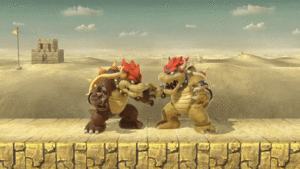 Whirling Fortress in Ultimate. | |
| Users | Bowser Giga Bowser |
| Universe | Mario |
Whirling Fortress (スピニングシェル, Spinning Shell) is Bowser's up special move.
Overview
When using Whirling Fortress, Bowser retreats into his shell and spins rapidly while damaging nearby foes. The grounded version initially only had two hits but as of Super Smash Bros. 4, it is a multi hitting attack, with the aerial version has always been a multi hitting attack. It is similar in execution to Donkey Kong's Spinning Kong, being a move that makes the user quickly spin around with a mostly-horizontal recovery, though in later games the two have been somewhat differentiated. The move has very low startup lag in every game (especially compared to the rest of Bowser's moveset), which makes it a notoriously strong out of shield option in every Smash title, being a key part of how Bowser gets out of disadvantageous game states.
This special attack is shared by Giga Bowser, both in his boss appearance in Melee and in his playable appearance in Brawl and Super Smash Bros. 4. It grants him multiple frames of invincibility, making it difficult to attack him out of the move. In Melee, Giga Bowser's Fortress also gave him much more vertical recovery when used in midair, and the ground attack can deliver multiple hits to nearby opponents; in Brawl, however, the ground attack only deals up to two hits, reducing its overall damage output.
In Super Smash Bros. Melee
In Melee, Whirling Fortress is known for the defensive and maneuvering attributes it adds to Bowser's metagame, which fills several holes in Bowser's otherwise slow metagame. As a result, it is widely regarded as one of the few benefits in Bowser’s kit there. Several unique properties make it highly beneficial to Bowser's kit;
- It has very little start-up (5 frames), during which Bowser is invincible, and has relatively little cooldown lag.
- Bowser cannot get shield grabbed if used in sequence.
- It hits throughout most of its animation (on the ground).
- It allows Bowser to move quickly and suddenly in one direction, being much faster than his normal movement speed.
- It has high knockback on the ground, and inflicts high damage in the air (32% if all hits connect perfectly).
- It can be used to edgeguard quickly and efficiently. Spinning off the side of a stage leads directly to an edgehog, known as Fortress hogging.
The above properties make Melee's iteration of Whirling Fortress a versatile move. It can also be used as a damaging and effective replacement to Bowser's quick but laggy roll, jump-canceled out of shield to discourage overly aggressive opponents, and clank with an opponent's move with decent timing. However, the ground attack can only deal up to two hits, and if any of the hits get blocked, Bowser will be highly vulnerable to punishment by his opponents, which includes getting grabbed. As a result, the ground attack is not safe to use against shields.
Fortress hogging
Fortress hogging is a technique exclusive to Melee that allows Bowser to grab onto the edge after simply using his Whirling Fortress on the stage. It was popularised by MagnuM. Fortress hogging is performed by timing the Whirling Fortress so that the end of the animation allows Bowser to fall past the stage and in turn, grab on to the edge. However, on stages where there are sloped edges, like Yoshi's Story, Bowser will automatically Fortress hog onto the edge regardless of the position he is facing, given he is not facing away from the stage after falling.
Fortress hogging is useful for quickly edgehogging a recovering opponent, greatly assisting in his edgeguarding-centric game plan. Quickly reaching the ledge after knocking a foe back, against characters launched lower and forced to go to the ledge, it can be hard to challenge. Naturally, it can also be used defensively, making use of ledge intangibility to stave off pressure. Using Whirling Fortress for these roles is much, much faster than running or jumping, and the hitboxes can make it somewhat difficult to contest.
In Super Smash Bros. Brawl
In Brawl, Whirling Fortress's damage output and knockback were lowered, but the height gained when airborne was increased, greatly assisting Bowser's previously meagre recovery. Due to the knockback changes, however, there are situations where it can be unsafe on hit. Combined with it being frame 6, it is significantly worse as an out of shield option; this startup has remained the same ever since. This does little to deter the move from being an effective out of shield option, however, still remaining above-average relative to the cast. Plus, the KO potential from Melee remains, with the first hit still taking stocks at around 125%. Fortress hogging was removed, which is a significant blow to Bowser's edgeguarding, and the move has not seen use in this fashion outside of niche situations since.
In Super Smash Bros. 4 onwards
In Super Smash Bros. 4, pressing the special move button repeatedly during the move—specifically after the initial rise for best results—will give Bowser marginally more height, somewhat similarly to Dr. Tornado. It also travels much faster and further than before. As an attack, the ground attack was reworked to deal multiple weak hits—up to 8, with the last hit delivering the most knockback instead of two strong hits—making its use as an out of shield option more reliable. The attack is also safer to use against shields, as the multiple hits make it harder for opponents to punish Bowser; they can still take the full impact of the final hit if they drop their shield too early. This trend continued into Ultimate, though its massive damage in the air was significantly nerfed.
Instructional quotes
| Spin on the ground to launch opponents skyward, or do it to get back onto the stage. | ||
| Get additional loft while airborne to make recoveries a snap. | ||
| Spin inside your shell, and hit foes with your spikes. | ||
| Ducks inside his shell and spins. Can be moved sideways while spinning. |
Customization
Special Move customization was added in Super Smash Bros. 4. These are the variations:
| 1. Whirling Fortress | 2. Flying Fortress | 3. Sliding Fortress |
|---|---|---|
| "Duck inside your shell and spin. You can move sideways while spinning." | "Spins high into the air but doesn't deal damage." | "Spin while sliding quickly to send opponents flying. Less vertical range." |
- Whirling Fortress: Default.
- Flying Fortress: Has slightly increased startup, and increases vertical distance, to about twice the regular height, at cost of horizontal distance and damage dealt. Launches foes sideways, only hitting once for 4% damage clean (despite the game saying it does no damage). Synergizes well with Dash Slash, where the Claw can move Bowser horizontally and then Flying Fortress to go vertically. However, when using this move while taking knockback, it won't rise as high or at all. Bowser also sustains slightly increased landing lag.
- Sliding Fortress: Increased horizontal distance, going as far as the entire stage of Battlefield on the ground, and 2/3 the length in the air. Only hits once, doing 6% damage and reduced knockback, however possesses a bigger hitbox, especially in the air. Takes longer to start up than the default move, making it less useful as a quick out of shield option. Also has increased endlag and landing lag as well. Less vertical reach than the standard version.
Origin
While unique to Smash Bros., it is similar to how Koopas retreat into their shells when jumped on in the Super Mario series which, can be held and thrown or kicked by the Mario Bros. as a spinning attack. In Super Mario Bros. 3, when the player jumps on any of the Koopalings, they will fly in the air inside their shell. Ludwig von Koopa had a move similar to Whirling Fortress in Super Mario World. In Mario Kart: Double Dash!!, released a few years later, a special item called the "Bowser's Shell" was given to Bowser and Bowser Jr., featuring a large, spinning Bowser shell, vaguely similar to Whirling Fortress.
Despite the above, Bowser himself never used this move, and in fact was never seen retreating into his shell in any Nintendo-developed game prior to the move's debut in Super Smash Bros. Melee. Like the Egg Roll and Green Missile, however, the move's concept later led back into the Nintendo-affiliated Mario series starting with an appearance as Bowser's defensive power shot in Mario Power Tennis, and Bowser also has used the move in New Super Mario Bros U. In Super Paper Mario, Bowser performs a similar move in one of his Stylish Move animations. In Mario + Rabbids Kingdom Battle, Bowser (as MegaDragonBowser) uses the Whirling Fortress during the final phase of the final boss fight.
Gallery
Whirling Fortress in Super Smash Bros. 4
